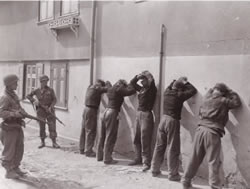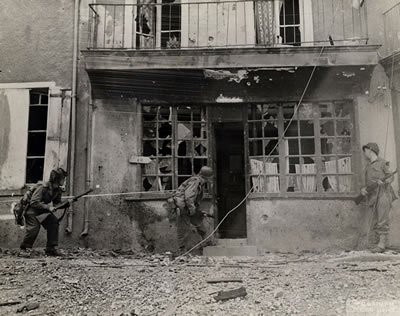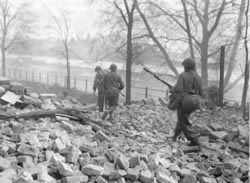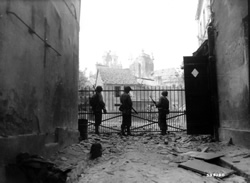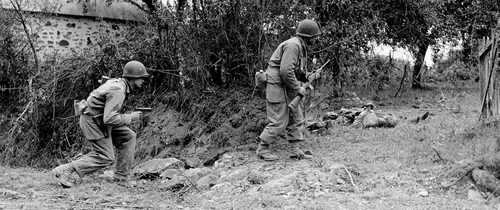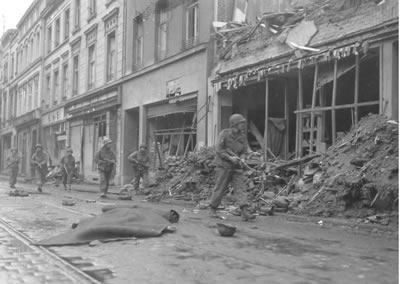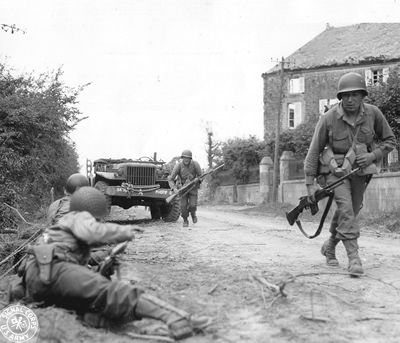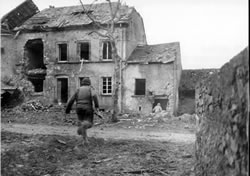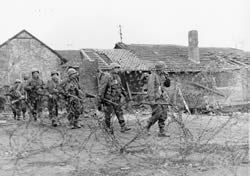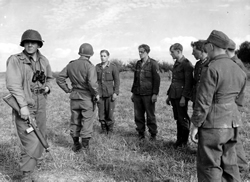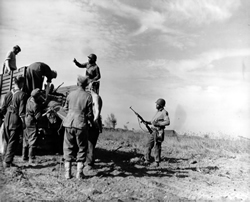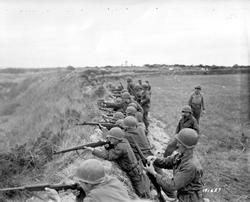WWII G.I. Weapon Carrying Methods
Published: August 30, 2010
Author & Researcher: Charles McFarlane
Contributor & Editor: Mike Ellis
Section II: Combat
In this section one sees much more variety. The full port arms is still very prevalent, a holdover from training. Most combat methods can be classified by how fast one could travel (movement speed), and how easy it was to fire (reflexive speed). Obviously it was more difficult to get off a shot when the rifle was tucked under the arm, compared to carried at full port arms. Thus, a Soldier would carry a rifle based on personal preference and tactical needs. Some basic trends are outlined below.
Under Arm Hang (movement-low | reflexes-very high)
The GI counterpart to the German "snapschuss", the "under arm hang" was a technique best suited to sudden snap shots. The rifle is carried with both hands at 45 degrees, muzzle to the ground. Most images show GIs focused intently ahead, but ready to jerk the rifle upward at moment's notice if the need arises. This position was most used when GIs expected to come into contact at any moment, and had to be ready to get off a shot while still moving and observing.
Note the man to the rear. He's jumpy, on his guard, and ready to shoot if a prisoner makes a move.
An interesting shot indeed: the man near the door is ready to assault the room. His rifle is in the under arm hang, but he can bring it up for a shot if needed. A man on each side is at port arms, ready to advance, or take a shot as necessary.
Infantry Journal - December 1944: Snap Shooting in Close Combat
Low Port Arms (movement-medium | reflexes-medium)
As one would expect, the danger inherent to combat allowed Soldiers to carry rifles in a more relaxed manner. One such position was similar to full port arms, but with the rifle nearly horizontal. I'll call it "low port arms". This required less effort, but lowered the muzzle of the rifle to ground level where rounds could potentially strike anyone standing near. For this reason it was prohibited to hold the M1 horizontally during training, but combat infantrymen saw no problem with the technique. It allows the same amount of mobility as “full port arms”, but is slightly faster to get off a shot.
Full Port Arms (movement-medium | reflexes-medium)
Old habits die hard. Many Soldiers continued to carry the rifle at the full port arms when they transitioned to combat. It was an average all-around carry method with a good mixture of mobility and reflex speed.
Cradled (movement-high | reflexes-low)
In combat, the "easy order arms" position placed a soldier's hand over the muzzle of a loaded rifle. Worse, that same muzzle was often pointed upward at the Soldier's armpit, torso, or face. As an alternative, one finds combat images of Soldiers cradling loaded weapons in the armpit. Weight is supported by one arm only, counterbalanced upward into the arm. Cradling is much safer than "easy order arms", so long as one remembers that the muzzle is still pointed horizontally, potentially at others nearby. It is a stereotypical technique of the WWII GI.
Note the man in front. He's resting, obviously unconcerned by the prisoners lined up before him as he cannot easily fire a shot.
One Hand Balanced (movement-very high | reflexes-very low)
In war, one's life can depend on the ability to make a quick dash through an open area. Much like German Soldiers, GIs found it cumbersome to run or walk with a rifle at port arms. As a result, both sides adopted a one hand hold, at the weapon's balance point. The arm was allowed to loosely hang, and the main purpose was to keep the rifle out of the way of the Soldier's legs. It can also be seen in use by Soldiers on the march.
Note how the rear Soldier still holds his weapon at full port arms.
One Handed (movement- high | reflexes-medium)
The M1 carbine, weighing around 5 pounds, was so light and handy that there are many images of it being held with a single hand at the pistol grip. While there are many possible reasons for this, the most common was to allow the Soldier to keep one hand near the trigger while having a second hand free to signal to Soldiers, operate a radio, or direct prisoners. There are also some images of the M1 rifle and other martial arms held the same way, likely for similar reasons. The method was limited in use only because the accuracy of a shot in this position was much lower than with the “under arm hang”.
This section is only the tip of the iceberg, but it does cover the major techniques. As you can see, there are many safe ways to authentically carry a blank-loaded weapon at reenactments without resorting to the “low ready” commonly seen in Iraq. What about at display events, you ask?
Section I: How They Were Taught. These images cover citizen Soldiers in training, some holding a rifle for the first time, some not.
Section II: Theatre Maneuvering and Combat Situations. This is a look at GIs in a tactical setting, where combat experience required new methods.
Section III: Non Combat. This is the most relevant for reenactors, with group shots and posed pictures showing GIs in relaxed situations.
90th IDPG Articles




